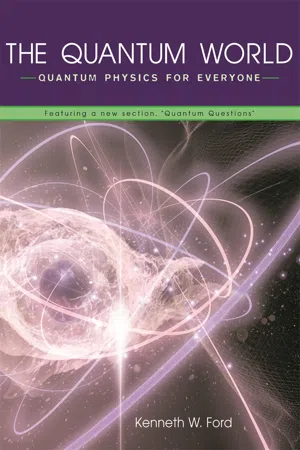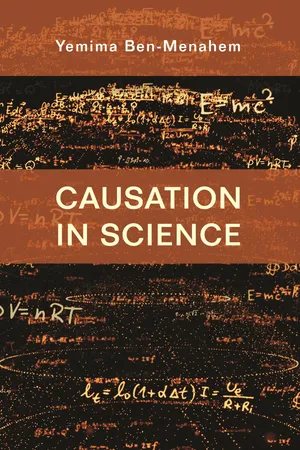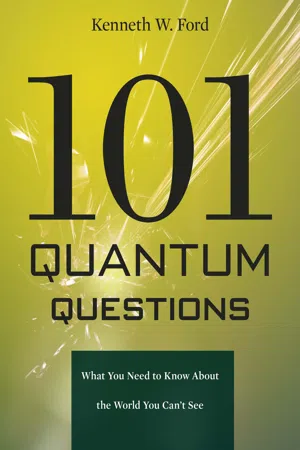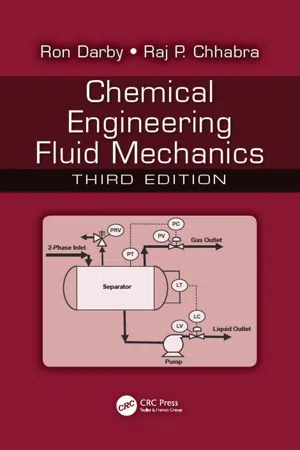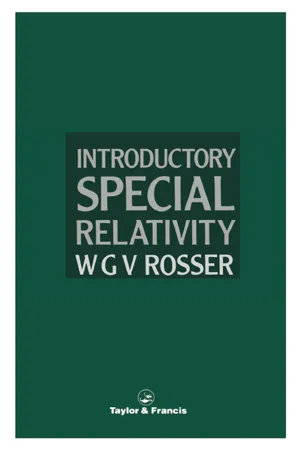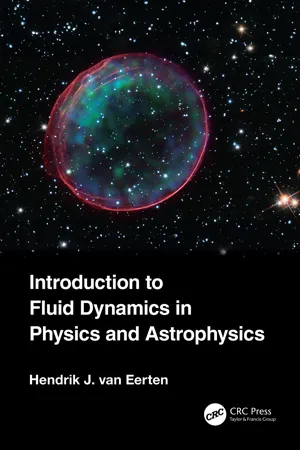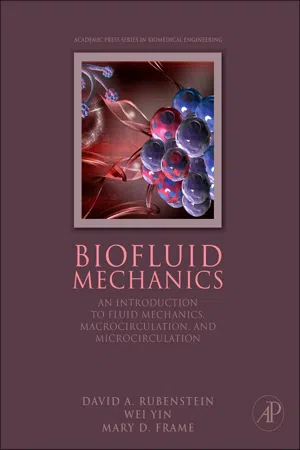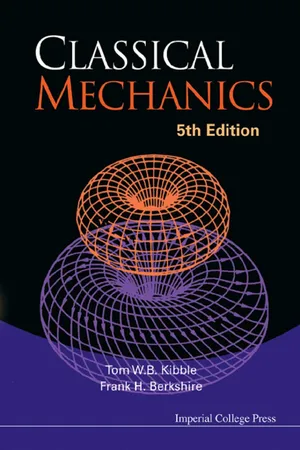Physics
Conservation Laws
Conservation laws in physics refer to fundamental principles that state certain physical quantities, such as energy, momentum, and electric charge, remain constant in isolated systems over time. These laws are essential for understanding and predicting the behavior of physical systems and are widely used in various branches of physics, including mechanics, thermodynamics, and electromagnetism.
Written by Perlego with AI-assistance
Related key terms
Related key terms
1 of 4
Related key terms
1 of 3
11 Key excerpts on "Conservation Laws"
- eBook - ePub
Doing Physics with Scientific Notebook
A Problem Solving Approach
- Joseph Gallant(Author)
- 2012(Publication Date)
- Wiley(Publisher)
Chapter 6Conservation Laws
Conservation Laws are fundamentally important in physics. We say a quantity is “conserved” when its total amount never changes. Its initial value equals its final value equals its value at all times in between. In this chapter you’ll meet two of the most important conserved quantities, Energy and Momentum.Conservation Laws are also powerful problem-solving tools. Even though they are consequences of Newton’s Laws, the approach to using them is different than the cause-and-effect methods of the last chapter. When we used Newton’s 2nd Law, we applied it to each object separately. When we use a conservation law, we’ll look at the system as a whole, not at the individual parts, and keep track of the total amount of the conserved quantity. Still, our goal is the same: to understand and explain changes in motion.Definitions
To understand and explain changes in motion, we need to consider both velocity and mass. Stopping a train moving at 5 mi/h is not the same as stopping an empty shopping cart moving at 5 mi/h. They have the same speed, but not the same mass. Catching a baseball moving at 5 mi/h is not the same as catching one moving at 100 mi/h. They have the same mass, but not the same speed.We can define a new vector called momentum as the product of mass times velocity. This is such a useful and important concept that when Newton used the word “motion” in the Principia, he often meant what we today call momentum.(6.1)The magnitude of the momentum is p = mv and its direction is the same as the velocity vector. The metric unit of momentum is the kg m/s.Calculate the momentum of a 1500 kg car moving at a speed of 15 mi/h. Do the same for a baseball moving at a speed of 80 mi/h. Which has more momentum?Example 6.1Some typical valuesSolution.Use Eq. (6.1) to create an expression for the car’s momentum using the given values. Select the car’s velocity and apply Evaluate Numerically in-place to convert it to meters per second, then Evaluate - eBook - ePub
- Benjamin Crowell(Author)
- 2018(Publication Date)
- Studium Publishing(Publisher)
1-ml pipette and bulb . . . . . . . . . . . . . . . . . . . . . . . 1/groupmagnetic stirrer . . . . . . . . . . . . . . . . . . . . . . . . . . . . 1/grouptriple-beam balance . . . . . . . . . . . . . . . . . . . . . . . . 1/groupIntroduction
Styles in physics come and go, and once-hallowed principles get modified as more accurate data come along, but some of the most durable features of the science are its Conservation Laws. A conservation law is a statement that something always remains constant when you add it all up. Most people have a general intuitive idea that the amount of a substance is conserved. That objects do not simply appear or disappear is a conceptual achievement of babies around the age of 9-12 months. Beginning at this age, they will for instance try to retrieve a toy that they have seen being placed under a blanket, rather than just assuming that it no longer exists. Conservation Laws in physics have the following general features:Physicists trying to find new Conservation Laws will try to find a measurable, numerical quantity, so that they can check quantitatively whether it is conserved. One needs an operational definition of the quantity, meaning a definition that spells out the operations required to measure it.Conservation Laws are only true for closed systems. For instance, the amount of water in a bottle will remain constant as long as no water is poured in or out. But if water can get in or out, we say that the bottle is not a closed system, and conservation of matter cannot be applied to it.The quantity should be additive. For instance, the amount of energy contained in two gallons of gasoline is twice as much as the amount of energy contained in one gallon; energy is additive. An example of a non-additive quantity is temperature. Two cups of coffee do not have twice as high a temperature as one cup.Conservation Laws always refer to the total amount of the quantity when you add it all up. If you add it all up at one point in time, and then come back at a later point in time and add it all up, it will be the same. - eBook - ePub
The Quantum World
Quantum Physics for Everyone
- Kenneth W. Ford(Author)
- 2005(Publication Date)
- Harvard University Press(Publisher)
This is no surprise, for everything in the large-scale world is built ultimately of subatomic units. So you can think of the causal link going from small to large: energy, momentum, angular momentum, and charge are conserved in the large-scale world because they are conserved in the subatomic world. The Conservation Laws that govern these quantities are regarded as absolute. An absolute conservation law is one for which no confirmed violation has ever been seen and which is believed to be valid under all circumstances. Moreover, we have theoretical reason to believe that these four laws are absolute. Relativity and quantum theory join to predict that these laws should be valid. But experiment is the final arbiter. No amount of beautiful theory trumps experiment. Calling these Conservation Laws absolute must be as tentative as every other firm pronouncement about nature. Energy In Chapter 6, I introduced the “downhill rule” for quantum jumps. A spontaneous transition must be from a higher to a lower-energy state. A particle can decay only into particles whose total mass is less than the mass of the decaying particle. And, as described earlier in this chapter, energy conservation also plays an essential role in “uphill” events such as the creation of new particles in a proton-proton collision. There is such abundant evidence that the energy after a reaction is the same as the energy before that the law of energy conservation becomes a practical tool for analyzing the complex debris created in particle collision. Momentum Momentum conservation is so well established that it, like energy conservation, becomes a tool of analysis in particle processes. With the help of these laws, physicists can work backward to deduce the masses of new particles that are created. One of the prohibitions resulting from the joint workings of energy conservation and momentum conservation is the prevention of one-particle decays - Daniel E. Rosner(Author)
- 2012(Publication Date)
- Dover Publications(Publisher)
2Governing Conservation Principles
INTRODUCTION
Approach
Chemically reacting fluids, including gas mixtures, can be quantitatively understood in terms of two types of “laws” applied to matter treated as a continuum:- Conservation Laws, which summarize the experience of the last three centuries on the behavior of all forms of matter;
- “Constitutive” laws, which quantitatively describe the behavior of certain subclasses of “fluids” (e.g., perfect gas mixtures, elastic solids, etc.).
The conservation principles, to which we first direct our attention, ensure that, for any fluid, in any state of motion, the following quantities are either conserved or, more generally, “balanced”:Mass Total mixture mass Individual chemical species (e.g., CH4 , O2 , CO2 , etc.) mass Individual chemical element (e.g., C, O, S, N, etc.) mass Momentum Total linear momentum of the mixture (a vector) Total angular momentum of the mixture (a vector) Energy Total energy (thermodynamic + kinetic) (First Law of Thermodynamics) Kinetic (mechanical) energy Entropy7 Total entropy of mixture (describing the consequences of transformations between forms of energy that are not thermodynamically equivalent (Second Law) and identifying all sources of irreversibility and the nature of entropy transport by diffusion). Each of these quantities is associated with a “field density,” i.e., a spatial concentration of that quantity, related, in turn, to the local material mass density, as shown in Table 2-1 . Note that while most of these field densities are scalars (defined by one number at each point/instant), ρ v is a vector field (defined by three numbers at each point/instant).These conservation principles apply not only to any fluid, but to any region of space (subject to the continuum restriction ). Thus, we state them below in three important forms, applicable to a control volume (CV) that is:- i. of arbitrary size/shape (leading to integral equations);
- ii. fully differential (leading to partial differential equations (PDEs) relating the above-mentioned local
- eBook - ePub
- Yemima Ben-Menahem(Author)
- 2018(Publication Date)
- Princeton University Press(Publisher)
18 The discovery of the conservation of angular momentum, which likewise follows from Newton’s system, took almost another century; it was formulated and proved by Leonard Euler and Daniel Bernoulli.In chemistry, in contrast to mechanics, the question of whether mass is conserved in all chemical reactions was a major issue, and was still undecided in the mid-seventeenth century. The budding science of chemistry had, however, already made several contributions of its own to the understanding of matter: gases had come to be seen as matter; atomistic theories were applied in chemical research; and the concepts of element, compound, and mixture were formed (though no method of distinguishing them in practice was yet available). In 1785, Lavoisier, whose meticulous experiments had convinced him that mass is neither created nor destroyed in chemical reactions, announced the principle that mass is conserved in a closed system. Lavoisier’s principle became an essential tool for analyzing chemical reactions.Meanwhile, other forms of matter—electricity and heat—were being conjectured. Benjamin Franklin conceived of electricity as consisting of atoms of an electric substance, atoms sufficiently small to penetrate ordinary matter. When these electric atoms were uniformly distributed, he contended, they could not be detected, whereas uneven distributions gave rise to electrical phenomena. Their accumulation manifested itself in what Franklin called “positive” electricity, and their dearth in “negative” electricity. Drawing an analogy with ordinary atoms, he surmised that electric atoms are neither created nor destroyed, from which conservation of the quantity of electricity followed as a simple corollary. Franklin’s monistic model of electricity was subsequently superseded by Coulomb’s dualistic model. Initially, the dualistic model seemed to conflict with the principle of conservation of mass. How could two different substances neutralize each other, as positive and negative electric charges should, according to the model, without violating this principle? In the face of doubts about the nature of electricity, Faraday formulated the conservation of electric charge in a manner independent of any specific model. His law permitted the creation of charge as long as only pairs of equally strong positive and negative charges were created. It still followed, though, that in a closed system the net charge remains constant even if additional electric charges are created within the system, say by friction of its constituent parts. Although the law of conservation of electric charge was inspired by the law of conservation of mass, the former actually proved to be more basic, surviving as a scientific law long after its precursor had to be modified.19 - eBook - ePub
- Kenneth W. Ford, Paul Hewitt(Authors)
- 2011(Publication Date)
- Harvard University Press(Publisher)
cookie conservation law doesn’t arise because individual cookies are conserved. Cookie conservation is a law in the large, but not in the small.However, for the “big four” of classically conserved quantities—energy, momentum, angular momentum, and electric charge—we do believe that the Conservation Laws hold down to the tiniest domains of space and time, and that, at all scales, these laws are absolute (insofar as we dare say that anything in the universe is absolute).π+ → μ+ + νFIGURE35 In this example of pion decay, numerous quantities are conserved.A simple example that shows all four Conservation Laws at work (and actually more) is the decay of a positively charged pion into a positively charged muon (which is actually an antimuon) and a neutrino of the muon flavor (see Figure 35 ):Energy conservation is reflected in the “downhill” character of the decay. The masses of the product particles add up to less than the mass of the pion, so mass energy decreases. The muon and neutrino then fly apart with enough kinetic energy to balance the energy books. Momentum conservation is reflected in how the product particles fly apart. Suppose that the pion is initially at rest, patiently awaiting its inevitable end. Then its momentum is zero. Accordingly, the total momentum of the muon and neutrino must also be zero. These two particles fly apart back-to-back with equal momentum. By the rules of vector addition, the two oppositely directed momenta add to zero. Angular momentum conservation also involves vector addition (since angular momentum, like ordinary momentum, is a vector quantity). The spin of the pion is zero. The muon and neutrino each have ½ unit of spin, which, if oppositely directed, can also add to zero. Charge conservation - eBook - ePub
- Ron Darby, Raj P. Chhabra(Authors)
- 2016(Publication Date)
- CRC Press(Publisher)
5 Conservation Principles“As simple as possible, but no simpler.”—Albert Einstein, 1879–1955, PhysicistI. THE SYSTEMAs discussed in Chapter 1 , the basic principles that apply to the analysis and solution of flow problems include the conservation of mass, energy, and momentum, in addition to appropriate transport relations for these conserved quantities. For flow problems, these Conservation Laws are applied to a system, which is defined as any clearly specified region or volume of fluid with either macroscopic or microscopic dimensions (this is also sometimes referred to as a “control volume”), as illustrated in Figure 5.1 . The material (fluid) within the system is assumed to be a continuum, with physical properties that can be defined at all points within the system. This means that only dimensions which are very large compared to the molecular or particulate structure of the material are considered. The general conservation law is{−}Rate of Xinto the system{=}Rate of Xout of the system{Rate of accumulation}of X in the systemwhere X is the conserved quantity, that is, mass, energy, or momentum. In the case of momentum, because a “rate of momentum” is equivalent to a force (by Newton’s second law), the “rate in” term must also include any (net) forces acting on the system. It is emphasized that the system is not the “containing vessel”per se (e.g., a pipe, tank, or pump) but is the fluid contained within the designated boundary. We will show how this generic expression is applied for each of the conserved quantities.II. CONSERVATION OF MASSA. MACROSCOPIC MASS BALANCEFor a given system (e.g., Figure 5.1 ), each entering stream (i) will carry mass into the system (at rate ṁi) and each exiting stream (o) carries mass out of the system (at rate ṁo). Hence, the conservation of mass, or “continuity,” equation for the system is∑i n−m ˙i=∑o u tm ˙odm sd t(5.1) where ms - eBook - ePub
- W G V Rosser(Author)
- 2017(Publication Date)
- CRC Press(Publisher)
A full discussion of high-energy physics goes beyond the scope of this book. The interested reader is referred to the books by Dodd (1984) and Perkins (1987). It is found that extra Conservation Laws are applicable in certain cases, such as the laws of conservation of charge, parity and baryon number. The full theories must be used if one wants to calculate the probability that a particular process takes place. However, if the theories used are Lorentz-covariant, that is if they obey the principle of relativity when the Lorentz transformations are used, then the dynamics of the collisions must always be consistent with the relativistic laws of conservation of energy and conservation of momentum.6.6.4 Example: the creation of a pion To illustrate how the laws of conservation of momentum and energy can be applied to events in which new particles are created, consider the reaction:γ + p → n +π +,Fig. 6.4 An incident γ ray collides with a stationary proton to give a charged pion and a neutron.where an incident photon (γ ray) denoted γ, with energy Eγ , collides with a stationary proton (p), producing a neutron (n) and a positive pion (π+ ). We shall determine Eγ , given that in the laboratory frame ∑ the pion is emitted at an angle of 90° to the direction of the incident photon with a kinetic energy Tπ = 50 MeV, as shown in Fig. 6.4 . Let the neutron be emitted at an angle ɸ to the direction of the incident photon with energy En and momentum pn .Since mπ c2 = 139.6 MeV and Tπ = 50 MeV, the (total) energy of the pion isE π= 50 + 139.6 Mev = 189.6 MeV .Using equation (6.7) , we find that its momentum is given bycApplying the law of conservation of energy, we havep π==()E π 2−m π 2c 41 / 2= 128.3 MeV .[]−(2189.6 MeV)(2139.6 MeV)1 / 2E γ+m pc 2=E π+E n. - Hendrik Jan van Eerten(Author)
- 2024(Publication Date)
- CRC Press(Publisher)
2 The Conservation Laws of Fluid DynamicsDOI: 10.1201/9781003095088-2There are four fundamental states of matter in the universe, solids, gases, liquids and plasmas, plus a plethora of more exotic states that only exist at the intersections of the four and/or at very specific extreme physical conditions (such as extreme cold or pressure). Solids excepted, the remaining three fundamental states describe continuum states of matter that can flow and deform freely and that, up to a point, can be split up in arbitrary smaller subdivisions that maintain the same physical properties. The behaviour of these three states—gases, liquids and plasmas—are governed by the laws of fluid dynamics. Viscosity will play a larger role for liquids than it does for gases, and plasmas are unique in that they contain many freely moving charged particles and therefore respond directly to electromagnetic forces. But all types of fluids share a common framework in that they obey a series of Conservation Laws that are cast in a form capable of dealing with the continuum nature of the fluid. It is the assumption that the fluid under consideration is something that can be subdivided arbitrarily that makes fluid dynamics into a macroscopic description of matter, as opposed to a microscopic theory that explicitly describes individual particles.This book is about formulating these Conservation Laws and exploring their consequences when they are adapted to various situations. When applied to liquids, this is the subject of hydrodynamics, although the terminology is not strict, and the prefix hydro- is admittedly sometimes also applied to fluids other than liquids. When adapted to plasmas, this is the subject of magnetohydrodynamics, abbreviated ‘MHD’, which connects to the rich and complicated field of plasma physics- eBook - ePub
Biofluid Mechanics
An Introduction to Fluid Mechanics, Macrocirculation, and Microcirculation
- Wei Yin, Mary D. Frame(Authors)
- 2011(Publication Date)
- Academic Press(Publisher)
Chapter 3. Conservation LawsIn this chapter, we develop the Conservation Laws that govern many fluid flows. First, we discuss the variation in hydrostatic pressure within a static fluid, which allows us to develop relationships for the forces that act on fluid elements. Buoyancy is addressed because many implantable cardiovascular devices will experience buoyancy forces when in use. The conservation of mass, the conservation of momentum (with and without acceleration), the conservation of energy, and the Navier-Stokes equations are derived in this chapter. The Bernoulli principle is discussed as a means to obtain some meaningful data regarding the pressure distribution, the height difference, and the velocity within a fluid, if certain assumptions are met and are appropriate. These laws are fundamental to biofluid mechanics principles and will be referred to throughout the remaining chapters in the textbook.Keywords Hydrostatic Pressure, Conservation of Mass, Conservation of Momentum, Conservation of Energy, Navier-Stokes Equations, Bernoulli EquationsLearning Outcomes1. Develop equations that govern pressure variation within a static fluid 2. Determine the buoyancy forces that act on objects immersed within a fluid 3. Develop a general relationship for the time rate of change of any fluid system property 4. Apply the generalized formula for the time rate of change of a system property to the conservation of mass, conservation of momentum, and conservation of energy 5. Describe the conservation of momentum principle with acceleration 6. Derive the Navier-Stokes equations 7. Explain the Bernoulli principle and the assumptions inherent in this principle3.1. Fluid Statics Equations
Fluid statics problems deal with fluids that either are at rest or are only undergoing constant velocity rigid body motions. This implies that the fluid is only subjected to normal stresses because by definition a fluid will continually deform under the application of a shear stress. Shear stress would induce angular deformations within the fluid (see Figure 2.15 ) and therefore acceleration in particular directions. Another way to think about these types of problems is that the relative position of all fluid elements remains the same after loading. Therefore, the fluid elements would only experience pure translation or pure rotation. These types of problems fall under the class of hydrostatics and the analysis methods for these problems are typically simpler than fluid dynamics problems. Newton’s second law of motion, simplified to the sum of the forces acting on the fluid is equal to zero ( - eBook - ePub
- Tom W B Kibble, Frank H Berkshire(Authors)
- 2004(Publication Date)
- ICP(Publisher)
F. When the force is central, the angular momentum is conserved. Then the motion is confined to a plane, and the rate of sweeping out area in this plane is a constant.The use of these Conservation Laws greatly simplifies the treatment of any problem involving central or conservative forces. When the force is both central and conservative, they provide all the information we need to determine the motion of the particle, as we shall see in the following chapter.Lagrange’s equations are of great importance in advanced treatments of classical mechanics (and also in quantum mechanics). We have seen that they can be used to write down equations of motion in any system of co-ordinates, as soon as we have found the expressions for the kinetic energy and potential energy. In later chapters, we shall see that the method can readily and usefully be extended to more complicated systems than a single particle.Problems
1.Find which of the following forces are conservative, and for those that are find the corresponding potential energy function (a and b are constants, and a is a constant vector):(a)Fx = ax + by2 , Fy = az + 2bxy, Fz = ay + bz2 ;(b)Fx = ay, Fy = az, Fz = ax;(c)Fr = 2ar sin θ sin φ, Fθ = ar cos θ sin φ, Fφ = ar cos φ;(d)F = a ∧ r;(e)F = ra;(f)F = a(a · r).2.Given that the force is as in Problem 1(a), evaluate the work done in taking a particle from the origin to the point (1, 1, 0): (i) by moving first along the x-axis and then parallel to the y-axis, and (ii) by going in a straight line. Verify that the result in each case is equal to minus the change in the potential energy function.3.Repeat the calculations of Problem 2 for the force in 1(b).4.Compute the work done in taking a particle around the circle x2 + y2 = a2 , z = 0 if the force is (a) F = yi, and (b) F = xi. What do you conclude about these forces? (Use the parametrization x = a cos φ, y = a sin φ, z
Index pages curate the most relevant extracts from our library of academic textbooks. They’ve been created using an in-house natural language model (NLM), each adding context and meaning to key research topics.
Explore more topic indexes
Explore more topic indexes
1 of 6
Explore more topic indexes
1 of 4


